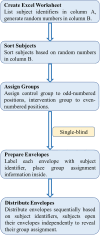The influence of mobile health intervention on the rate of prenatal diagnosis and pregnancy outcomes among pregnant women with high-risk prenatal screening results: protocol for a randomized controlled trial
- PMID: 40534908
- PMCID: PMC12175712
- DOI: 10.3389/fpsyt.2025.1582368
The influence of mobile health intervention on the rate of prenatal diagnosis and pregnancy outcomes among pregnant women with high-risk prenatal screening results: protocol for a randomized controlled trial
Abstract
Background: Prenatal diagnostics is a crucial process for ensuring the health of both pregnant women and their fetuses. However, the participation rate of high-risk pregnant women in prenatal diagnostics is often influenced by various factors, including anxiety, depression, and lack of family support. In recent years, mobile health (mHealth) interventions have become an important tool in improving maternal health management, especially in terms of behavior change. The Behavior Change Wheel (BCW) theory and the Family Health Theory (FHT) have been applied in various health interventions, but there are limited studies focusing on prenatal diagnostics.
Objective: The study aims to evaluate the impact of a mobile health intervention based on the Behavior Change Wheel theory and Family Health Theory on prenatal diagnostic participation rates and pregnancy outcomes in high-risk pregnant women, while exploring the role of family member involvement in improving maternal psychological health and pregnancy outcomes.
Methods: The study outlines a single-blind, interventional, randomized controlled trial conducted at the Inner Mongolia Maternity and Child Health Care Hospital. A total of 58 high-risk pregnant women will be included and randomly assigned to either the intervention group (29 participants) or the standard care group (29 participants). The intervention group will receive a 12-week mHealth intervention via the WeChat platform, including health education, emotional support, behavioral feedback, and family member participation. The standard care group will receive standard prenatal care. Primary outcomes include prenatal diagnostic needs and pregnancy outcomes, while secondary outcomes include health knowledge, anxiety and depression levels, decision conflict, and other factors. This study uses IBM SPSS Statistics 24.0 for data analysis, employing descriptive statistics, normality tests, Mann-Whitney U, Wilcoxon, and chi-square tests.
Discussion: The study proposes that a mobile health intervention based on the Behavior Change Wheel theory and Family Health Theory may effectively increase prenatal diagnostic participation and improve the psychological health and pregnancy outcomes of high-risk pregnant women. The active participation and emotional support of family members are expected to be key components in achieving these improvements. This research provides new insights and evidence for the application of mHealth interventions in prenatal screening.
Keywords: behavior change wheel; family health theory; high-risk pregnancy; mobile health; pregnancy outcomes; prenatal diagnosis.
Copyright © 2025 Wang, Wang, Jiang, Liu, Bao, Wang, Huang, An, Wang and Wang.
Conflict of interest statement
The authors declare that the research was conducted in the absence of any commercial or financial relationships that could be construed as a potential conflict of interest.
Figures






Similar articles
-
Exploring engagement patterns within a mobile health intervention for women at risk of gestational diabetes.Womens Health (Lond). 2025 Jan-Dec;21:17455057251327510. doi: 10.1177/17455057251327510. Epub 2025 Jun 5. Womens Health (Lond). 2025. PMID: 40470610 Free PMC article. Clinical Trial.
-
Designing, validation and evaluation of an mHealth app for prenatal health promotion based on the unified theory of acceptance and use of technology: A mixed methods study protocol.Sci Rep. 2025 Jul 29;15(1):27603. doi: 10.1038/s41598-025-05609-6. Sci Rep. 2025. PMID: 40730798 Free PMC article.
-
Assessing the comparative effects of interventions in COPD: a tutorial on network meta-analysis for clinicians.Respir Res. 2024 Dec 21;25(1):438. doi: 10.1186/s12931-024-03056-x. Respir Res. 2024. PMID: 39709425 Free PMC article. Review.
-
Quality Assessment of Web-Based Information Related to Diet During Pregnancy in Pregnant Women: Cross-Sectional Descriptive Study.JMIR Form Res. 2025 Jun 3;9:e64630. doi: 10.2196/64630. JMIR Form Res. 2025. PMID: 40460424 Free PMC article.
-
Prenatal administration of progestogens for preventing spontaneous preterm birth in women with a multiple pregnancy.Cochrane Database Syst Rev. 2019 Nov 20;2019(11):CD012024. doi: 10.1002/14651858.CD012024.pub3. Cochrane Database Syst Rev. 2019. PMID: 31745984 Free PMC article.
References
-
- Guifang L. Research progress on the influencing factors of birth defects. Electronic J Clin Med Literature. (2020) 7:194. doi: 10.16281/j.cnki.jocml.2020.02.166 - DOI
-
- Tingting Z. Causes of birth defects and tertiary prevention. Family Life Guide. (2023) 39:52–3.
LinkOut - more resources
Full Text Sources

